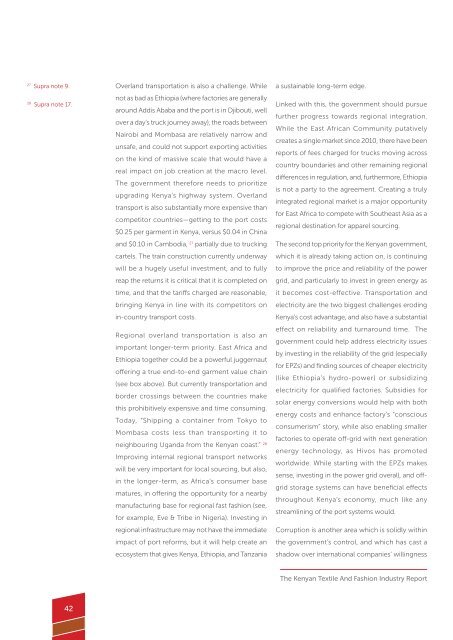Create successful ePaper yourself
Turn your PDF publications into a flip-book with our unique Google optimized e-Paper software.
27<br />
Supra note 9.<br />
28<br />
Supra note 17.<br />
Overland transportation is also a challenge. While<br />
not as bad as Ethiopia (where factories are generally<br />
around Addis Ababa and the port is in Djibouti, well<br />
over a day’s truck journey away), the roads between<br />
Nairobi and Mombasa are relatively narrow and<br />
unsafe, and could not support exporting activities<br />
on the kind of massive scale that would have a<br />
real impact on job creation at the macro level.<br />
The government therefore needs to prioritize<br />
upgrading Kenya’s highway system. Overland<br />
transport is also substantially more expensive than<br />
competitor countries—getting to the port costs<br />
$0.25 per garment in Kenya, versus $0.04 in China<br />
and $0.10 in Cambodia, 27 partially due to trucking<br />
cartels. The train construction currently underway<br />
will be a hugely useful investment, and to fully<br />
reap the returns it is critical that it is completed on<br />
time, and that the tariffs charged are reasonable,<br />
bringing Kenya in line with its competitors on<br />
in-country transport costs.<br />
Regional overland transportation is also an<br />
important longer-term priority. East Africa and<br />
Ethiopia together could be a powerful juggernaut<br />
offering a true end-to-end garment value chain<br />
(see box above). But currently transportation and<br />
border crossings between the countries make<br />
this prohibitively expensive and time consuming.<br />
Today, “Shipping a container from Tokyo to<br />
Mombasa costs less than transporting it to<br />
neighbouring Uganda from the Kenyan coast.” 28<br />
Improving internal regional transport networks<br />
will be very important for local sourcing, but also,<br />
in the longer-term, as Africa’s consumer base<br />
matures, in offering the opportunity for a nearby<br />
manufacturing base for regional fast fashion (see,<br />
for example, Eve & Tribe in Nigeria). Investing in<br />
regional infrastructure may not have the immediate<br />
impact of port reforms, but it will help create an<br />
ecosystem that gives Kenya, Ethiopia, and Tanzania<br />
a sustainable long-term edge.<br />
Linked with this, the government should pursue<br />
further progress towards regional integration.<br />
While the East African Community putatively<br />
creates a single market since 2010, there have been<br />
reports of fees charged for trucks moving across<br />
country boundaries and other remaining regional<br />
differences in regulation, and, furthermore, Ethiopia<br />
is not a party to the agreement. Creating a truly<br />
integrated regional market is a major opportunity<br />
for East Africa to compete with Southeast Asia as a<br />
regional destination for apparel sourcing.<br />
The second top priority for the Kenyan government,<br />
which it is already taking action on, is continuing<br />
to improve the price and reliability of the power<br />
grid, and particularly to invest in green energy as<br />
it becomes cost-effective. Transportation and<br />
electricity are the two biggest challenges eroding<br />
Kenya’s cost advantage, and also have a substantial<br />
effect on reliability and turnaround time. The<br />
government could help address electricity issues<br />
by investing in the reliability of the grid (especially<br />
for EPZs) and finding sources of cheaper electricity<br />
(like Ethiopia’s hydro-power) or subsidizing<br />
electricity for qualified factories. Subsidies for<br />
solar energy conversions would help with both<br />
energy costs and enhance factory’s “conscious<br />
consumerism” story, while also enabling smaller<br />
factories to operate off-grid with next generation<br />
energy technology, as Hivos has promoted<br />
worldwide. While starting with the EPZs makes<br />
sense, investing in the power grid overall, and offgrid<br />
storage systems can have beneficial effects<br />
throughout Kenya’s economy, much like any<br />
streamlining of the port systems would.<br />
Corruption is another area which is solidly within<br />
the government’s control, and which has cast a<br />
shadow over international companies’ willingness<br />
The Kenyan Textile And Fashion Industry Report<br />
42


